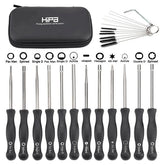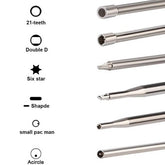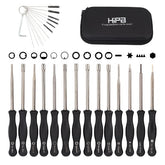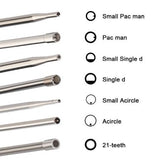Common Carburetor Issues and How to Fix Them in 2-Cycle Small Engines
25 May 2023
0 Comments
As the heart of any engine, the carburetor plays a vital role in ensuring smooth and efficient operation. It is responsible for mixing air and fuel in the correct proportions, and if it isn't functioning properly, your engine will suffer from a range of problems. In this blog, we'll look at some common carburetor issues and how to fix them in small engines. Whether you're a seasoned mechanic or just getting started, these tips will help you keep your engine running at its best.
Dirty or Clogged Carburetor
One of the most common carburetor issues is a dirty or clogged carburetor. Dirt, debris, and other contaminants can clog the small passages and jets in the carburetor, which affects the fuel flow and air mixture. Symptoms of a clogged carburetor include difficulty starting the engine, poor idle, and reduced power output.
To fix this issue, you need to clean the carburetor thoroughly. Remove the carburetor from the engine and disassemble it. Soak the carburetor in carburetor cleaner, and then use a wire brush to remove any remaining debris. Pay attention to the small passages and jets, which are especially prone to clogging. Once you have cleaned the carburetor, reassemble it and reinstall it on the engine.
Leaking Carburetor
Another common carburetor issue is a leaking carburetor. A leaking carburetor can cause fuel to leak out of the engine, which is not only a fire hazard but also a waste of fuel. Symptoms of a leaking carburetor include a strong smell of gasoline, poor fuel economy, and reduced power output.
To fix this issue, you need to inspect the carburetor for any visible leaks. Check the gaskets and seals for cracks or signs of wear, and replace them if necessary. You may also need to tighten the bolts that hold the carburetor in place or adjust the float level if it is not set correctly. If the carburetor is still leaking after you have made these adjustments, you may need to replace it entirely.
Stuck or Damaged Float
The float in the carburetor is responsible for controlling the fuel level in the carburetor bowl. If the float is stuck or damaged, it can cause the fuel level to be too high or too low, which affects the engine's performance. Symptoms of a stuck or damaged float include difficulty starting the engine, poor idle, and reduced power output.
To fix this issue, you need to inspect the float for any visible damage or signs of wear. If the float is stuck, you may need to clean or replace it. If the float is damaged, you will need to replace it entirely. You may also need to adjust the float level if it is not set correctly.
Incorrectly Adjusted Carburetor
An incorrectly adjusted carburetor can cause a range of problems, including poor fuel economy, reduced power output, and difficulty starting the engine. Symptoms of an incorrectly adjusted carburetor include a rough idle, backfiring, and excessive exhaust emissions.
To fix this issue, you need to adjust the carburetor to the correct specifications. Refer to the manufacturer's instructions or a repair manual for your specific engine model. Adjust the idle speed, air-fuel mixture, and choke settings as necessary. Be sure to use the correct tools and follow the correct procedures to avoid damaging the carburetor.
In conclusion, a properly functioning carburetor is essential for the performance and longevity of your engine. By understanding the common carburetor issues and how to fix them, you can keep your small engine running smoothly and efficiently. Remember to always follow the manufacturer's instructions and safety guidelines when working on your engine,
Dirty or Clogged Carburetor
One of the most common carburetor issues is a dirty or clogged carburetor. Dirt, debris, and other contaminants can clog the small passages and jets in the carburetor, which affects the fuel flow and air mixture. Symptoms of a clogged carburetor include difficulty starting the engine, poor idle, and reduced power output.
To fix this issue, you need to clean the carburetor thoroughly. Remove the carburetor from the engine and disassemble it. Soak the carburetor in carburetor cleaner, and then use a wire brush to remove any remaining debris. Pay attention to the small passages and jets, which are especially prone to clogging. Once you have cleaned the carburetor, reassemble it and reinstall it on the engine.
Leaking Carburetor
Another common carburetor issue is a leaking carburetor. A leaking carburetor can cause fuel to leak out of the engine, which is not only a fire hazard but also a waste of fuel. Symptoms of a leaking carburetor include a strong smell of gasoline, poor fuel economy, and reduced power output.
To fix this issue, you need to inspect the carburetor for any visible leaks. Check the gaskets and seals for cracks or signs of wear, and replace them if necessary. You may also need to tighten the bolts that hold the carburetor in place or adjust the float level if it is not set correctly. If the carburetor is still leaking after you have made these adjustments, you may need to replace it entirely.
Stuck or Damaged Float
The float in the carburetor is responsible for controlling the fuel level in the carburetor bowl. If the float is stuck or damaged, it can cause the fuel level to be too high or too low, which affects the engine's performance. Symptoms of a stuck or damaged float include difficulty starting the engine, poor idle, and reduced power output.
To fix this issue, you need to inspect the float for any visible damage or signs of wear. If the float is stuck, you may need to clean or replace it. If the float is damaged, you will need to replace it entirely. You may also need to adjust the float level if it is not set correctly.
Incorrectly Adjusted Carburetor
An incorrectly adjusted carburetor can cause a range of problems, including poor fuel economy, reduced power output, and difficulty starting the engine. Symptoms of an incorrectly adjusted carburetor include a rough idle, backfiring, and excessive exhaust emissions.
To fix this issue, you need to adjust the carburetor to the correct specifications. Refer to the manufacturer's instructions or a repair manual for your specific engine model. Adjust the idle speed, air-fuel mixture, and choke settings as necessary. Be sure to use the correct tools and follow the correct procedures to avoid damaging the carburetor.
In conclusion, a properly functioning carburetor is essential for the performance and longevity of your engine. By understanding the common carburetor issues and how to fix them, you can keep your small engine running smoothly and efficiently. Remember to always follow the manufacturer's instructions and safety guidelines when working on your engine,










